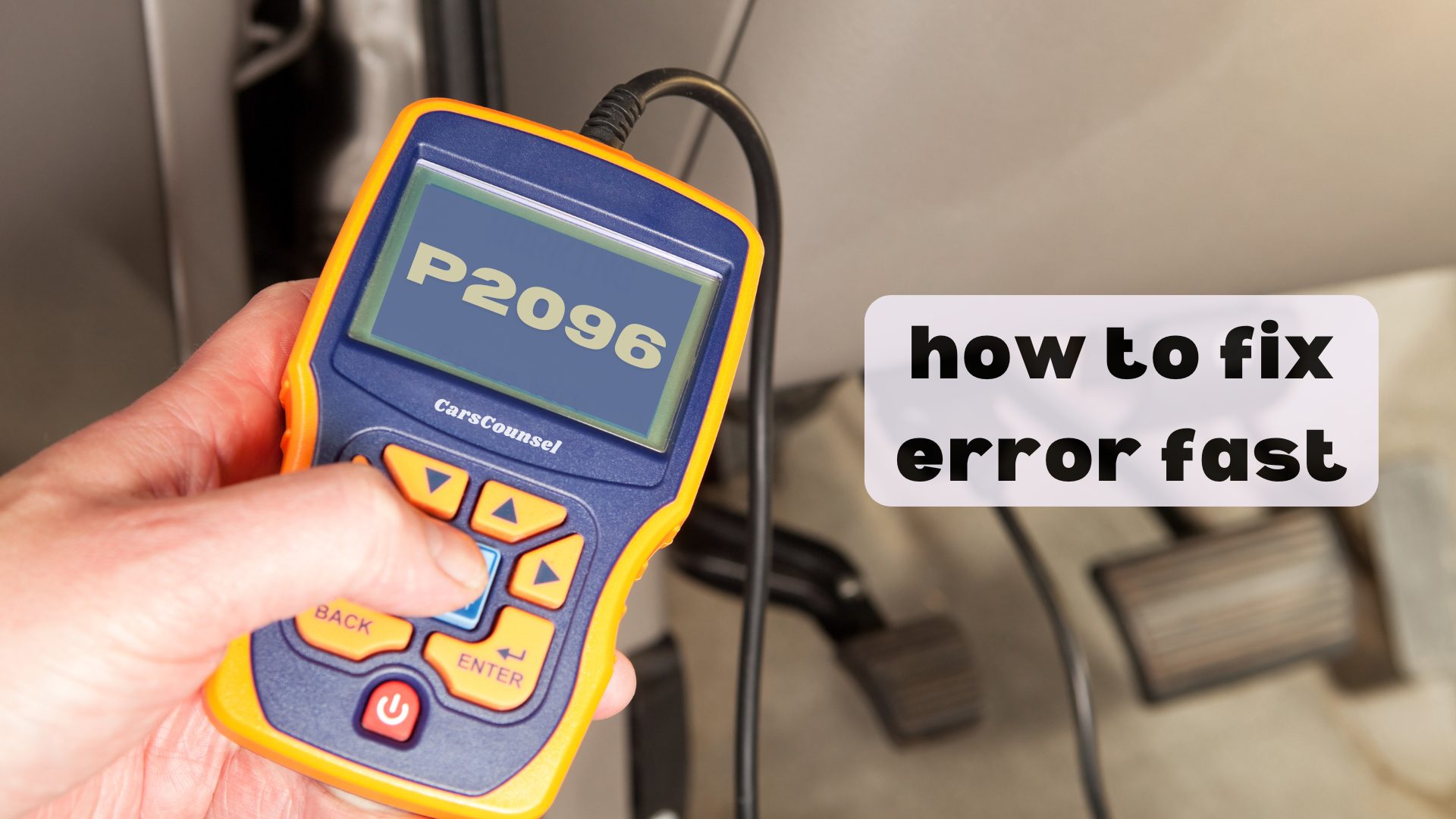When your vehicle’s check engine light comes on and you get a P2096 code, it can be stressful, but you can fix it quickly.
Start by looking at your engine for obvious problems like loose connections or vacuum leaks.
Diagnostic tools are used to read troublesome OBD2 codes and check sensor data.
Testing the oxygen sensors and looking at parts like the fuel pressure regulator can really help.
Want to keep your engine running smoothly and avoid big repair bills?
Let’s go through each step to fix this error efficiently.

Quick Navigation
Key Takeaways
- Look for and fix any visible vacuum leaks using a smoke machine to make sure everything is sealed properly.
- Test and replace any bad oxygen sensors to keep the air-fuel mix right.
- Check and clean or replace clogged fuel filters to make sure fuel flows properly.
- Look at and fix any damaged or corroded wiring that might affect sensor signals.
What Is the P2096 Code?
The P2096 code means there’s an imbalance in your car’s fuel system, with too much air and not enough fuel. This code acts as a warning signal from your car’s computer, telling you something might be wrong with the fuel system.
When the fuel mix is off, the engine control unit (ECU) notices this and triggers the P2096 code. To figure out what’s wrong, you’ll need to look at data from different sensors and check the fuel system parts closely.
Understanding this code is crucial for keeping your engine running well and avoiding bigger problems. Don’t ignore this warning; it’s important to diagnose it quickly.
Impact on Engine Performance
When the P2096 code shows up, you’ll notice your engine isn’t performing well. It has less power, uses more fuel, and might even misfire. Your car won’t accelerate like it used to, and you’ll see your fuel efficiency drop.
This issue makes your engine work harder, which can wear it out faster. If you don’t fix it soon, you could face more serious problems and costly repairs.
Addressing the P2096 code right away is crucial for keeping your engine running smoothly and extending its life.
Potential Causes of P2096
Diagnosing the P2096 code usually involves checking for a few common problems: a bad fuel pressure regulator, a clogged fuel filter, or damaged wiring.
These issues can mess with the fuel mix, making the engine run too lean. A faulty fuel pressure regulator mightn’t deliver enough fuel, and a clogged fuel filter can block the flow, both of which can trigger the code.
Damaged or corroded wiring can also mess with the signals between parts, upsetting the fuel system’s balance.
To keep your engine running smoothly and avoid lean conditions, make sure these parts are working right.
Regular checks and maintenance can help you catch these issues early.
Common Symptoms to Watch For
Symptoms to Watch For
Poor engine performance is a key sign you should look out for if you have a P2096 code. This code usually means your engine is running too lean, which can hurt fuel efficiency and engine life.
Here are some other signs to keep an eye on:
- Lower fuel efficiency: Your car uses more fuel than normal, so you have to fill up the tank more often.
- Engine misfires: The engine might misfire because the fuel-air mix is off, which can hurt overall performance.
These signs are important to monitor. Fixing them quickly can help keep your engine in good shape and make the most of your fuel.
Affected Car Models
Certain car models are more likely to have the P2096 code because of problems with their fuel systems. For example, the Hyundai Sonata and Kia Optima often have issues with their fuel pressure regulators. The Mazda CX-7 and Ford Focus also have fuel system problems that can cause this code.
Cars with gasoline direct injection (GDI) systems, no matter the brand, are especially at risk. Knowing which parts are compatible with your vehicle can help you spot potential problems early. Fixing these issues sooner rather than later can save you money.
It’s important to keep an eye on these specific models and their common issues to manage maintenance better and avoid expensive repairs. Pay attention to how your car handles the P2096 code.
Initial Diagnostic Steps
When dealing with the P2096 code in your vehicle, start by looking over the engine for any obvious signs of damage or wear. Check for cracked hoses, loose connections, and worn-out parts. This quick look can help you find immediate problems before getting into more detailed checks.
Use diagnostic tools to read trouble codes and gather data on fuel trim and sensor performance.
- Check for vacuum leaks: Use a smoke machine to find any leaks in the intake system.
- Inspect wiring and connectors: Look for any damaged or corroded wiring that could mess with sensor signals.
These steps will give you a good starting point for more in-depth diagnostics.
Testing Oxygen Sensors
To test the oxygen sensors properly, you’ll need a digital multimeter and a basic understanding of your vehicle’s wiring.
First, find out what type of oxygen sensors are in your vehicle; they’re usually either zirconia or wideband.
Locate the sensor and disconnect it. Set your multimeter to measure voltage and connect the probes to the sensor’s signal wire and ground.
Start the engine and watch the voltage readings. For zirconia sensors, the voltage should go up and down between 0.1V and 0.9V. For wideband sensors, check that the readings match what the manufacturer says they should be.
If the readings are consistently wrong, you probably have a bad sensor. These steps can help you figure out if the oxygen sensor is causing the P2096 error code.
Fixing Vacuum Leaks
After making sure the oxygen sensors are working right, the next step is to fix vacuum leaks to ensure no extra air is getting into the combustion system.
Start by checking for leaks in hoses, gaskets, and seals. Look for any signs of wear or damage. Using a smoke machine can help you find leaks accurately. Once you find a leak, either seal it properly or replace the faulty part.
- Check hoses and gaskets: Look for any cracks, splits, or loose connections.
- Use a smoke machine: Send smoke into the intake system to spot leaks.
Fixing vacuum leaks quickly ensures your engine runs smoothly and helps solve the P2096 code effectively.
Replacing Faulty Components
Replacing faulty parts is crucial for fixing the P2096 code and ensuring your engine runs smoothly. Start by finding out which parts are not working, like the oxygen sensor, MAF sensor, or fuel pressure regulator. You can buy these parts from trusted auto parts stores or online shops. Make sure to compare prices to keep repair costs low. Here’s a simple guide to common parts and why they matter:
| Part | What It Does | Why It Matters |
|---|---|---|
| Oxygen Sensor | Checks oxygen levels in the exhaust | Ensures the right fuel mix |
| MAF Sensor | Measures air entering the engine | Keeps fuel usage efficient |
| Fuel Pressure Regulator | Controls fuel pressure in the system | Stops the engine from running lean |
Replacing these parts quickly can save you from more costly repairs in the future.
Preventative Maintenance Tips
Taking care of your vehicle through regular maintenance can help you avoid problems like the P2096 code.
Start with consistent care of the fuel system to keep your car running smoothly.
Regularly use diagnostic tools to keep an eye on your vehicle’s health and catch any issues early.
- Change the fuel filter as recommended to prevent it from getting clogged and to ensure proper fuel flow.
- Regularly check the fuel pressure regulator to make sure the fuel pressure is correct.
More OBD-II Codes
Frequently Asked Questions
Can a P2096 Code Affect the Car’s Emissions Test Results?
Yes, a P2096 code can impact your car’s emissions test results. Emissions laws need your engine to run perfectly, and if tests show your car is running lean, it might fail the emissions test.
How Much Does It Cost to Fix a P2096 Code?
Fixing a P2096 code can cost anywhere from $100 to $500. This depends on what’s needed for diagnostics and parts. Sometimes, unexpected problems can make it more expensive.
Can I Drive My Car With a P2096 Code Error?
You can drive your car with a P2096 code, but it’s not a good idea. It could affect your car’s safety and how well the engine runs. Fix the problem soon to avoid damage, lower gas mileage, and bad engine performance.
Does the P2096 Code Only Appear in GDI Engines?
The P2096 code isn’t just for GDI engines, but it’s more often found in them. It means the engine is running lean, which can mess with how it performs. Keeping up with regular maintenance can help stop this issue in all types of fuel-injected engines.
Are There Any Temporary Fixes for the P2096 Code?
You can try quick fixes like cleaning the MAF sensor, looking for vacuum leaks, or changing the fuel filter. These might help for a while, but it’s best to see a mechanic for a full check-up and long-term fix.
Conclusion
You now know how to handle the P2096 code. By checking for visible damage, testing the oxygen sensors, and fixing any vacuum leaks, you’re on the right track to solving the problem.
Remember, these steps not only fix the current issue but also help prevent expensive future repairs. Regular maintenance of your fuel system is crucial.
Don’t let a small error code turn into a bigger problem—stay proactive and keep your engine running smoothly.

